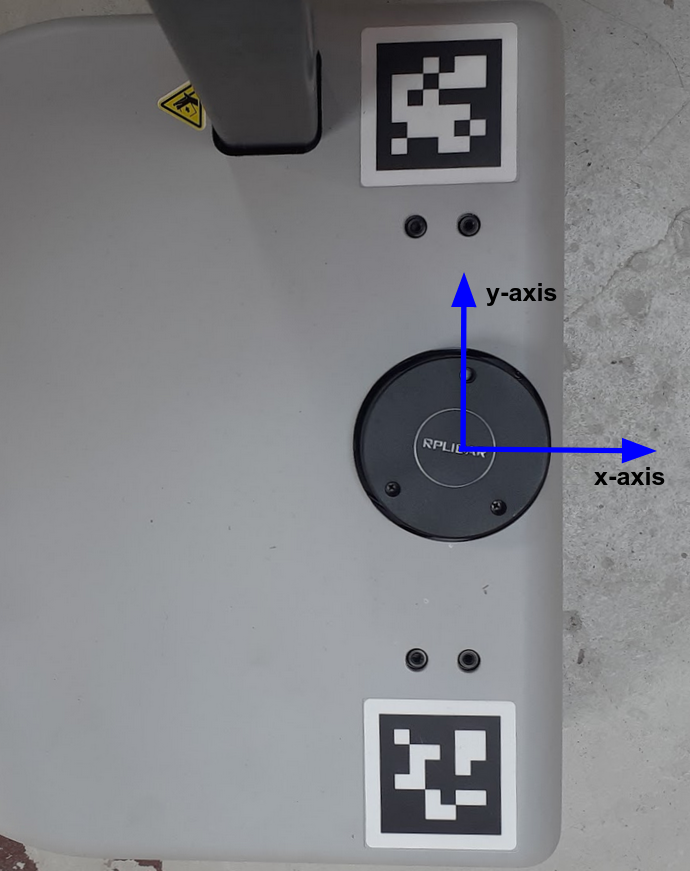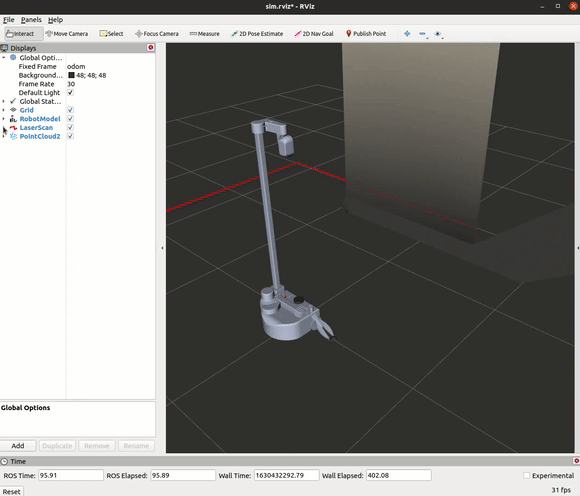Filter Laser Scans
Example 2
Note
ROS 2 tutorials are still under active development.
This example aims to provide instructions on how to filter scan messages.
For robots with laser scanners, ROS provides a special Message type in the sensor_msgs package called LaserScan to hold information about a given scan. Let's take a look at the message specification itself:
# Laser scans angles are measured counter clockwise,
# with Stretch's LiDAR having both angle_min and angle_max facing forward
# (very closely along the x-axis) of the device frame
#
std_msgs/Header header # timestamp data in a particular coordinate frame
float32 angle_min # start angle of the scan [rad]
float32 angle_max # end angle of the scan [rad]
float32 angle_increment # angular distance between measurements [rad]
float32 time_increment # time between measurements [seconds]
float32 scan_time # time between scans [seconds]
float32 range_min # minimum range value [m]
float32 range_max # maximum range value [m]
float32[] ranges # range data [m] (Note: values < range_min or > range_max should be discarded)
float32[] intensities # intensity data [device-specific units]
The above message tells you everything you need to know about a scan. Most importantly, you have the angle of each hit and its distance (range) from the scanner. If you want to work with raw range data, then the above message is all you need. There is also an image below that illustrates the components of the message type.

For a Stretch robot the start angle of the scan, angle_min, and
end angle, angle_max, are closely located along the x-axis of Stretch's frame. angle_min and angle_max are set at -3.1416 and 3.1416, respectively. This is illustrated by the images below.


Knowing the orientation of the LiDAR allows us to filter the scan values for a desired range. In this case, we are only considering the scan ranges in front of the stretch robot.
First, open a terminal and run the stretch driver launch file.
ros2 launch stretch_core stretch_driver.launch.py
Then in a new terminal run the rplidar launch file from stretch_core.
ros2 launch stretch_core rplidar.launch.py
To filter the lidar scans for ranges that are directly in front of Stretch (width of 1 meter) run the scan filter node by typing the following in a new terminal.
ros2 run stretch_ros_tutorials scan_filter
Then run the following command to bring up a simple RViz configuration of the Stretch robot.
ros2 run rviz2 rviz2 -d `ros2 pkg prefix stretch_calibration`/rviz/stretch_simple_test.rviz
Change the topic name from the LaserScan display from /scan to /filter_scan.

The Code
#!/usr/bin/env python3
import rclpy
from rclpy.node import Node
from numpy import linspace, inf
from math import sin
from sensor_msgs.msg import LaserScan
class ScanFilter(Node):
def __init__(self):
super().__init__('stretch_scan_filter')
self.pub = self.create_publisher(LaserScan, '/filtered_scan', 10)
self.sub = self.create_subscription(LaserScan, '/scan', self.scan_filter_callback, 10)
self.width = 1
self.extent = self.width / 2.0
self.get_logger().info("Publishing the filtered_scan topic. Use RViz to visualize.")
def scan_filter_callback(self,msg):
angles = linspace(msg.angle_min, msg.angle_max, len(msg.ranges))
points = [r * sin(theta) if (theta < -2.5 or theta > 2.5) else inf for r,theta in zip(msg.ranges, angles)]
new_ranges = [r if abs(y) < self.extent else inf for r,y in zip(msg.ranges, points)]
msg.ranges = new_ranges
self.pub.publish(msg)
def main(args=None):
rclpy.init(args=args)
scan_filter = ScanFilter()
rclpy.spin(scan_filter)
scan_filter.destroy_node()
rclpy.shutdown()
if __name__ == '__main__':
main()
The Code Explained
Now let's break the code down.
#!/usr/bin/env python3
import rclpy
from rclpy.node import Node
from numpy import linspace, inf
from math import sin
from sensor_msgs.msg import LaserScan
You need to import rclpy if you are writing a ROS Node. There are functions from numpy and math that are required within this code, that's why linspace, inf, and sin are imported. The sensor_msgs.msg import is so that we can subscribe and publish LaserScan messages.
self.width = 1
self.extent = self.width / 2.0
self.sub = self.create_subscription(LaserScan, '/scan', self.scan_filter_callback, 10)
Set up a subscriber. We're going to subscribe to the topic "/scan", looking for LaserScan messages. When a message comes in, ROS is going to pass it to the function "callback" automatically.
self.pub = self.create_publisher(LaserScan, '/filtered_scan', 10)
This declares that your node is publishing to the filtered_scan topic using the message type LaserScan. This lets any nodes listening on filtered_scan that we are going to publish data on that topic.
angles = linspace(msg.angle_min, msg.angle_max, len(msg.ranges))
points = [r * sin(theta) if (theta < -2.5 or theta > 2.5) else inf for r,theta in zip(msg.ranges, angles)]
new_ranges = [r if abs(y) < self.extent else inf for r,y in zip(msg.ranges, points)]
msg.ranges = new_ranges
self.pub.publish(msg)
def main(args=None):
rclpy.init(args=args)
scan_filter = ScanFilter()
Setup Scanfilter class with scan_filter = Scanfilter()
rclpy.spin(scan_filter)
Give control to ROS. This will allow the callback to be called whenever new messages come in. If we don't put this line in, then the node will not work, and ROS will not process any messages.